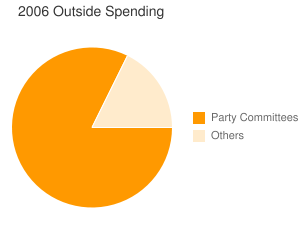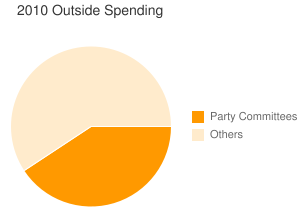The Sunlight Foundation, a non-profit group interested in government transparency, has a couple of charts that reflect the enormous growth in spending by outside groups (i.e., organizations other than the parties or the candidates themselves):
According to data obtained from the Federal Election Commission, fifty-nine percent of all outside spending on independent expenditures has come from non-party aligned groups while only forty-one percent comes from the party committees. This is a dramatic change from the 2006 midterms (as of October 19, 2006) when party committees accounted for eighty-two percent of all outside spending on independent expenditures and non-party aligned committees accounted for eighteen percent.
This includes those that actively support or oppose a candidate and advocate voting in a particular way; it isn’t counting the independent “electioneering communications,” where groups take a clear stance toward a candidate’s policies but don’t explicitly say to vote for or against them.
Here is the breakdown of spending from 2006:
And 2010:
Of course, the major cause for this was the Supreme Court’s decision in Citizens United v. Federal Election Committee. The decision allows outside groups to spend unlimited amounts and to actively take positions in ads, as long as they don’t specifically advocate voting for or against candidates and don’t coordinate with campaigns. They also are not required to disclose their donors.
Both Democrats and Republicans receive support from such groups, though Republicans benefit more thus far. For a breakdown of specific types of spending (including both independent spending and electioneering communications), the Sunlight Foundation has a great database here.



Comments 5
Nora — October 23, 2010
Dear World,
Please do not make your pie charts yellow. I just end up giggling about pac-man instead of looking at the chat.
Thanks,
Nora
Karyn — October 24, 2010
This speaks in terms of percentages and the change in percentages, but are party committees contributing roughly the same amount of money as they have in the past? If they are, that makes the increase in outside spending that much more. I was unable to tell from the article if this is the case. Can anyone offer clarification on this? Thanks.
John Mehoff — October 26, 2010
The American Federation of State, County and Municipal Employees (AFSCME) is the biggest spender of all groups, putting $87.5 million into television advertisements, phone calls, campaign mailings, and other political activities to support Democratic candidates in this election: http://online.wsj.com/article/SB1000...761790288.html